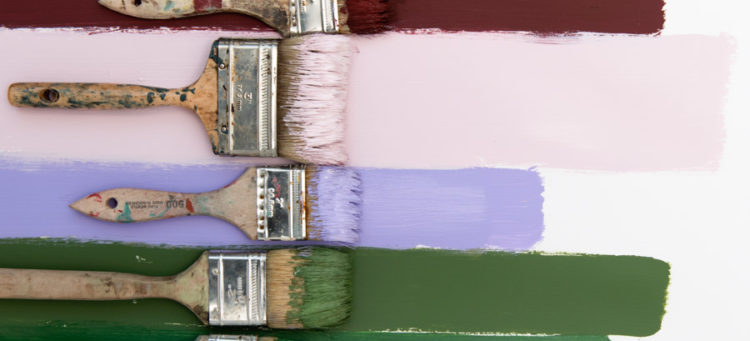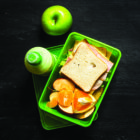
Truly Deeply Madly
Paint, instructions and advice: Painting Pointers You Won’t Brush Off
February, 2017
Whether you’re updating your home’s interior, sprucing up your outdoor space or just feeling crafty, nothing can colour your world like a fresh coat of paint. Not all paint jobs are created equal, however. Before you dip your brush, consider these tips to confidently choose the right paint for the right project.
Painting Indoors
Pick Your Paint: Latex paint is the top pick for indoor painting projects such as walls or ceilings. Compared to oil paint, latex paint is easier to work with and dries more quickly. Use the highest quality paint possible.
Pick Your Finish: The glossier the finish, the easier it is to clean. So choose a satin finish for kitchen or bathroom walls, which are prone to splatters and spills. For your trim and mouldings, use a semi-gloss finish to save them from showing every scuff mark.
Flatter finishes help hide imperfections such as unfilled nail holes or pesky roller marks. But they don’t spot clean as easily as the glossier finishes do. Consider flat or eggshell finish on walls in the lower-traffic areas of your home such as hallways or guest bedrooms.
Pick Your Brush: For covering large areas such as walls or ceilings, a roller is best. However, you will also need a brush to “cut in” the corners—a two-inch tapered brush is a good choice for this job and intricate surfaces such as trim and mouldings.
Proper Prep: In painting, preparation matters. Tape the areas around where you will be painting (like baseboards or the ceiling perimeter), and protect your floor with a drop cloth. Patch any cracks or holes with surfacing compound, and then sand to create a smooth surface. Be sure
the area is also dust free before you paint.
Prime Time: Don’t skip this essential step. Primer helps paint adhere, hides imperfections and covers stains. If your paint colour is bright or dark, you may want to tint your primer to reduce the number of coats you’ll need. Just ask the person at the paint counter if he or she recommends it.
Some paints are even sold as a primer-and-paint-in-one. Again, ask away!
Painting Outdoors
Pick Your Paint: For most outdoor surfaces, such as your home’s exterior or your deck, fence or patio furniture, you’ll be choosing between exterior paint and stain, the latter of which is for wood. Exterior paint coats the surface you’re painting and comes in solid colours; stain soaks into wood, enhancing its natural look and helping protect it from the elements.
If you go with exterior paint, choose an oil-based paint for its durability and water resistance. However, check that the previous paint job was also oil-based; if it was latex, use an exterior latex paint instead (or it could peel).
For stain, you’ll be choosing between water-based and oil-based. Water-based stains dry more quickly, have less odour and are easier to apply and clean than their oil-based counterparts. Oil-based stains provide more water-resistance, allow for a more even finish and require less long-term maintenance than water-based stains.
Pick Your Brush: Just like with indoor painting, the larger your surface area is, the larger the roller or brush you should use. Natural bristle brushes work best with oil-based paint or stain; use a nylon-polyester brush for any water-based paint or stain.
Proper Prep: To paint an outdoor surface, you’ll need to put in some prep time. Wash the surface you’ll be painting, scrape off any old or peeling paint and patch any damaged areas.
Getting Crafty
When it comes to crafting, there’s a perfect paint for practically any project.
Acrylic Paint: Acrylic paint (or craft paint) has a thick texture, dries quickly and comes in deep, rich hues. Use it on paper, canvas or wood.
Watercolour: Watercolour paint is non-toxic, easy to clean and comes in both transparent and opaque hues. Use it on watercolour paper or watercolour canvas.
Dishwasher-Safe Paint: Use oil-based paint pens or dishwasher-safe acrylic paint (both found at most craft stores) to decorate your dishes. Dishwasher-safe paint works on porcelain, ceramic and glass.
Fabric Paint: Fabric paint comes in many forms—tubes, jars, pens and even sprays—and is available in an endless array of colours. Use it on pretty much any fabric you like—nylon, cotton, rayon, linen, bamboo, silk—the list goes on.
Chalkboard Paint: Chalkboard paint lets you turn almost any flat surface into—you guessed it—a chalkboard! It’s available in a variety of shades and colours, and you can use it on your walls or furniture. t8n
- acrylic paint
- chalkboard paint
- fabric paint
- finish
- glossy
- oil-based
- paint
- preparation
- primer
- satin
- water-based
- watercolour













